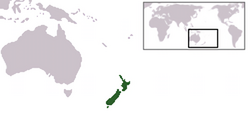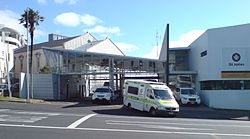Emergency medical services in New Zealand: Difference between revisions
Emrgmgmtca (talk | contribs) →Land ambulance: minor |
Emrgmgmtca (talk | contribs) →Land ambulance: correction |
||
| Line 21: | Line 21: | ||
<gallery caption="Land Ambulance in New Zealand" widths="250px" heights="180px" perrow="3"> |
<gallery caption="Land Ambulance in New Zealand" widths="250px" heights="180px" perrow="3"> |
||
File:St John Emergency Vehicles Auckland.jpg|Ambulance station in Auckland |
File:St John Emergency Vehicles Auckland.jpg|Ambulance station in Auckland |
||
File:ST John NZ Ambulance. |
File:ST John NZ Ambulance.JPG|Going to a call |
||
Image:Welly Unit.jpeg|Wellington Free Ambulance |
Image:Welly Unit.jpeg|Wellington Free Ambulance |
||
</gallery> |
</gallery> |
||
Revision as of 18:13, 16 February 2009
Emergency medical services in New Zealand | |
|---|---|
 | |
| Capital | Wellington [1] |
| Area | |
• Total | 268,000 km2 (103,000 sq mi) |
| Population | |
• July 2008 estimate | 4,173,460 |
| ISO 3166 code | NZ |
Emergency medical services in New Zealand are operated by two major organisations. In each case, the service consists of both volunteers and paid staff, and is subsidised by the government of New Zealand in many cases. Additional funding occurs by means of some billing for services to either government or health care agencies, or to individuals, and also by means of voluntary donations. In recent years, the government has begun to examine more sustainable funding for ambulance services.[2] Both services St John Ambulance in New Zealand and Wellington Free Ambulance have a long history of service to their communities, with the latter providing services since the 1920s and the former providing services since 1885.[3]
Organization
While both land ambulance service providers do have paid staff, they also rely very heavily on volunteer members to supplement paid staff. In most cases, paid staff tend to be concentrated in urban areas and in the management of rural areas, with rural response staff being largely volunteer-based. St. John Ambulance reports a total of 2,211 paid staff in New Zealand, supplemented by 7,647 volunteers.[4] By contrast, Wellington Free Ambulance currently staffs 82 paid paramedics and 57 volunteers.
Land ambulance
Land ambulance services are provided primarily by two organisations; Wellington Free Ambulance and St John Ambulance New Zealand. St. John Ambulance provides service to approximately 85 percent of the land mass of New Zealand, through a network of 553 ambulances and 183 ambulance stations.[5] St. John Ambulance reports the completion of approximately 274,108 emergency responses for the year ending July 1, 2008.[6] By contrast, Wellington Free Ambulance provides service to approximately 15 percent of the country, primarily in the capitol region. WFA operates eight ambulance stations, all in the lower half of the North Island of New Zealand, providing service to more than 460,000 residents. They perform an estimated 40,000 calls per year.[7]
- Land Ambulance in New Zealand
-
Ambulance station in Auckland
-
Going to a call
-
Wellington Free Ambulance
Air ambulance

Air ambulance and rescue services are frequently used necessities in a country which is largely rural and made up of islands. In both cases, the service is provided by means of a corporate sponsor, government subsidy, public donations, and the cooperation of the two land ambulance services. Westpac is a large banking corporation operating in both Australia and New Zealand. In New Zealand, Westpac undertook sponsorship of local rescue helicopters in cooperation with local EMS, just as it did in Australia. Unlike Australia, the need in New Zealand was different, and a fixed wing air ambulance service was also required. In New Zealand, both operations occur under the business name 'LifeFlight'. In the case of rescue helicopter operations, these are based in Wellington, and staffed by paramedics from Wellington Free Ambulance. These use EC-135 helicopters. Air ambulance operations are based in Auckland, and are staffed by either hospital personnel or paramedics from St. John Ambulance, depending on the medical needs (many are premature neonates) of the patient, or in Wellington, and staffed by WFA paramedics. These typically use pressurised and fully converted Fairchild Metro aircraft, equipped as flying Intensive Care units.[8] Air ambulance operations are not inexpensive, and it has been estimated that after corporate sponsorship and government subsidy, it is necessary to raise approximately $2,500NZ in donations for each flight that occurs.[9]
Models of care
The New Zealand system functions on the Anglo-American model of care,[10] with most care in the prehospital setting being conducted by paramedics. Other practitioners, including local physicians and midwives, do appear at calls from time to time, but spend much less time responding to emergency calls than the Franco-German model.[11]
Training
Training occurs across a broad range in New Zealand, and the range of training varies considerably between volunteer and paid staff. As a result, it is permissible to work on an ambulance with only a first aid certificate, or with a university degree in paramedicine. To some extent, availability of training may be affected by the location of volunteers, and also by their time availability, given full-time employment and other life commitments. There are, in fact, eight levels of training available.[12]It is quite common for New Zealand EMS staff to begin their careers as volunteers, and to progress into paid positions.
Basic and Intermediate
For the volunteer performing BLS functions, they will generally begin with basic and advanced first aid training, specifically the Pre-Hospital Emergency Care (PHEC) course, offered by St. John Ambulance. Such individuals may then receive additional before challenging the National Certificate in Ambulance (Patient Care and Transport) qualification,[13] through the New Zealand Qualifications Authority This certificate is generally required by either service prior to full-time employment.
Paramedic
Paramedics in New Zealand are graduates of a recognized three year (minimum) Bachelor of Health Science (Paramedic) degree. This level of qualification was pioneered by Wellington Free Ambulance in cooperation with Victoria University in Melbourne, Australia, but now reaches across New Zealand.[14] The New Zealand College of Paramedic Sciences operates in a joint venture arrangement with Whitereia Community Polytechnic to deliver a three-year Bachelor of Health Sciences (Paramedic) degree.[15] A similar program operates at AUT University, as well.[16] The ambulance services also provide an internship program as a part of the paramedic education process. Following completion of education requirements, candidates must pass a National Certificate in Ambulance (Paramedic) examination, in order to complete their qualifications. Some paramedics may also progress beyond this level to become Intensive Care Paramedics.
Skills
Basic and Intermediate
Basic life support providers use the same skill set used by BLS providers around the world. With additional training, some BLS providers may operate at an Intermediate Life Support level, including IV starts, and some drugs.[17]
Paramedic
Paramedics will initially complete ALS-A training, which will permit IV starts, administration of cardiac drugs, and the ability to direct cardiac resuscitation. The ALS-B qualification does not have a training program, but is indicative of additional experience. It permits the administration of narcotic analgesia and Naloxone by paramedics.[18]
Intensive Care Paramedics
Paramedics at this level require post-graduate education, and administer an increased range of resuscitation drugs. They also perform a broad range of patient care resuscitation skills including transcutaneous pacing, endotracheal intubation, needle thoracostomy, cricothyroidotomy, continuous positive airway pressure (CPAP), capnography, intraosseous infusions, thrombolysis and 12 lead electrocardiograms.[19]
Communications
The EMS system in New Zealand is served by three dispatch centres, located in Auckland, Wellington, and Christchurch. The dispatch centre in Christchurch provides coverage to the entire South Island, and is operated by St. John Ambulance. The dispatch centre in Auckland provides coverage for the north half of North Island, and is also operated by St. John Ambulance. The dispatch centre in Wellington provides coverage for the southern half of the North Island and coordinates all air ambulance operations, and is operated and staffed jointly by Wellington Free Ambulance and St John Ambulance. All three dispatch centres collaborate, and are capable of handling overflow of call volume for one another.[20] The call centre technology is fully integrated and seamless, providing a single, 'virtual' national dispatch centre. To illustrate, if an emergency has occurred in Christchurch but those 1-1-1 lines are all busy, the call will be forwarded to the dispatch centres in either Auckland or Wellington. The call will be answered, information gathered, and placed into the computer network. It will then appear as a pending call on the desk of the appropriate dispatcher in Christchurch, all seamlessly.
The national emergency number for ambulances in New Zealand is 1-1-1. The three dispatch centres also include significant advanced technologies, including AMPDS and Siren software for the triaging and assignment of calls. They also include a nationwide network of Automatic Vehicle Location (AVL), showing the location and current status of every ambulance in the country.[21] All dispatchers in New Zealand are certified Emergency Medical Dispatchers (EMDs), and meet the international standard for that qualification. Between them, the ambulance dispatch centres process approximately 300,000 calls per year originating with the 1-1-1 system. They also process an additional 800,000 calls per year from GPs, hospitals requesting transfers, medical alarm monitoring companies, and from paramedics themselves.[22]
See also
References
- ^ "All facts unless otherwise cited, are from: The CIA World Fact Book". Retrieved 2009-02-08.
- ^ "Towards Sustainable Funding for Ambulance Service (NZ Ministry of Health website)". Retrieved 2009-02-09.
- ^ "2008 Annual Report (website)" (PDF). Retrieved 2009-02-09.
- ^ "St John Ambulance National Performance Statistics (1)(website)". Retrieved 2009-02-09.
- ^ "St John Ambulance National Performance Statistics (2)(website)". Retrieved 2009-02-09.
- ^ "St John Ambulance National Performance Statistics (3)(website)". Retrieved 2009-02-09.
- ^ "Services We Provide (WFA Official website)". Retrieved 2009-02-09.
- ^ "LifeFlight home page". Retrieved 2009-02-09.
- ^ "How You Can Help (LifeFlight official website". Retrieved 2009-02-09.
- ^ Cooke MW, Bridge P, Wilson S. (2001). "Variation in emergency ambulance dispatch in Western Europe". The Scandinavian Journal of Trauma and Emergency Medicine. 9 (2): 57–66.
{{cite journal}}: CS1 maint: multiple names: authors list (link) - ^ Dick WF (2003). "Anglo-American vs. Franco-German emergency medical services system". Prehosp Disaster Med. 18 (1): 29–35, discussion 35–7. PMID 14694898.
- ^ "Frequently Asked Questions (1)(WFA website)". Retrieved 2009-02-11.
- ^ "National Certificate in Ambulance (Patient Care and Transport)" (PDF). Retrieved 2009-02-11.
- ^ "The Development of Professional Qualifications for Paramedics at Victoria University (JEPHC website)". Retrieved 2009-02-11.
- ^ "Whitereia Community Polytechnic (website)". Retrieved 2009-02-11.
- ^ "Course Description (AUT website)". Retrieved 2009-02-11.
- ^ "Frequently Asked Questions (2) (WFA website)". Retrieved 2009-02-11.
- ^ "Frequently Asked Questions (3) (WFA website)". Retrieved 2009-02-11.
- ^ "Ambulance Education and Training". Retrieved 2009-02-11.
- ^ "Comms Centre (WFA website)". Retrieved 2009-02-11.
- ^ "Comms Centre Technology (NZ govt 111 website)". Retrieved 2009-02-11.
- ^ "No. of Calls per Year (NZ govt 111 website)". Retrieved 2009-02-11.


